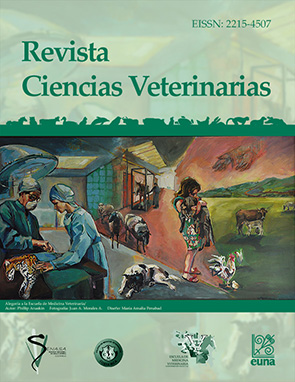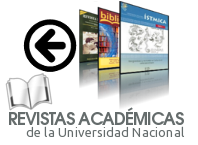Descriptive analysis of the conservation conditions of a foraging site for the Pacific green turtle (Chelonia mydas agassizii, Testudines: Chelonioidea) in Golfo Dulce, Costa Rica, based on the turtle’s state of health and the discovery of pesticides in the environment
DOI:
https://doi.org/10.15359/rcv.33-2.3Keywords:
Pacific green turtle, Chelonia mydas agassizii, toxic pollutants, clomazone, FPAbstract
The development of management strategies for the conservation of Golfo Dulce and of sea turtles requires inputs related to the current health status of the populations of the turtles. Several studies have linked the clinical manifestation of diseases such as fibropapillomatosis (FP) in sea turtles with environmental stressors and anthropogenic activities, which may result in the presence of contaminants and environmental degradation of foraging and nesting areas. This paper was prepared considering this link and as an environmental characterization of a foraging site based on the state of health of the Pacific green turtle (Chelonia mydas agassizii) and the environmental conditions of this site (a foraging site) in Golfo Dulce, Costa Rica, between 2010 and 2012. To this end, the physical condition of 77 turtles, the presence of fibropapillomatosis (FP) and the molecular detection of CFPHV were determined. An analysis was performed considering the following factors: land use and population density near the study area, as well as the presence of pesticides in samples of marine sediment, water and seagrass, and blood from 10 turtles. One of the results indicates that the general condition of the gulf is preserved, solely with the presence of rice crops near the area and a sector with a significantly growing population. The study determined the presence of the herbicide clomazone as well as the good health of the turtles studied, apparently free from FP. However, the possible FP casual agent was molecularly detected in 26% (20) of the sampled individuals. With this research, Golfo Dulce was recognized as an important foraging site with adequate conditions for the preservation and protection of the Pacific Green Sea Turtle.References
Aguirre, A.A., Spraker, T.R., Chaves, A., Du Toit L., Eure, W. & Balazs, G.H. 1999. Pathology of Fibropapillomatosis in Olive Ridley Turtles Lepidochelys olivacea Nesting in Costa Rica. Journal of Aquatic Animal Health. 11: 283-289.
Aguirre, A.A. & Lutz, P.L. 2004. Marine Turtles as Sentinels of Ecosystem Health: Is Fibropapillomatosis an Indicator? Eco Health J. Consort.1: 275-83. doi: 10.1007/s10393-004-0097-3.
Alfaro-Núñez, A., Frost Bertelsen, M., Bojesen, A., Rasmussen, I., Zepeda-Mendoza, L., Tange Olsen, M. & Gilbert, M. 2014. Global distribution of Chelonid fibropapilloma-associated herpesvirus among clinically healthy sea turtles. BMC EvolBiol. 14: 206. doi: 10.1186/s12862-014-0206-z.
Amorocho, D.F. & Reina, R.D. 2007. Feeding ecology of the East Pacific green sea turtle Chelonia mydas agassizii at Gorgona National. Endangered Species Research. 3: 43–51. doi: 10.3354/esr003043.
Bester, K. 2000. Effects of pesticides on seagrass beds. Helgoland Marine Research. 54: 95-98. doi: 10.1007/s101520050007.
Bessensen, B.L. & Corrigan, J. 2010. Reporte Final del Monitoreo de Especies Marinas en el Golfo Dulce, Costa Rica. http://osaconservation.org/wp-content/uploads/2012/05/Reporte-Final-del-Monitoreo-de-Especies-Marinas-en-el Golfo-Dulce.pdf (Accesado 9 de agosto 2015).
Bjorndal, K.A. 1980. Nutrition and grazing behaviour of the green turtle Chelonia mydas. Mar. Biol. 56:147-154. doi: 10.1007/BF00397131
Brenes, L., Berrocal, A., Meneses, A.I., Jiménez, C. & Orrego, C. 2013. Study on the etiology of fibropapillomatosis of olive ridley sea turtles (Lepidochelys olivacea) nesting in the National Wildlife Refuge at Ostional, Guanacaste, Costa Rica. Rev. Mar. Cost. 15: 119-134.
Chacón-Chaverri D., Martínez-Cascante, D.A., Rojas, D. & Fonseca, L.G. 2015a. Golfo Dulce, Costa Rica, un área importante de alimentación para la tortuga carey del Pacífico Oriental (Eretmochelys imbricata) Rev. Biol. Trop. 63 (Supl. 1): 351-362.
Chacón-Chaverri, D., D.A. Martínez-Cascante, D. Rojas, & L.G. Fonseca. 2015b. Captura por unidad de esfuerzo y estructura poblacional de la tortuga verde de Pacífico (Chelonia mydas) en el Golfo Dulce, Costa Rica. Rev. Biol. Trop. 63(Supl.1): 363-373.
Clark, R. B. 1992. Marine pollution. Claredon Press, Oxford.
Clomazone. 2010. http://www.ftm.una.ac.cr/plaguicidasdecentroamerica/index.php/base-de-datos/ingredientes-activos/135-clomazone (Accesado 3 de agosto 2015)
Copatti, C.E., Garcia, L.O. & Baldisserotto, B. 2009. Uma importante revisão sobre o impacto de agroquímicos da cultura de arroz em peixes. Biota Neotrop., 9(4): 235-242.
Cornelius, S.E. & Robinson, D.C. 1983. Abundance, distribution, and movements of olive ridley sea turtles in Costa Rica, III. U.S. Fish and Wildlife Service Endangered Species Report 13, Albuquerque, New Mexico, 52 pp.
Ernst, C.H., Altenburg, R.G.M. & Barbour, R.W. 1998. Turtlesoftheworld. De la base de datos de BiodiversidadMundial del Expert Center forTaxonomicIdentification (ETI), Amsterdam, The Netherlands, disponible en http://nlbif.eti.uva.nl/bis/turtles (Accesado 6 agosto 2015).
EOSL, Universidad de Alberta, ITCR–FONAFIFO. 2006. Cobertura de la tierra ocurrida en el 2005 FONAFIFO. (Shape). Escala No dada. Interpretación y clasificación de imágenes de satélite Landsat 7. Software: No dado. San José, Costa Rica: FONAFIFO.
ESRI. 2010. ArcGis (Versión 10.1) [software]. California, EEUU: ESRI.
FOOTPRINT. 2009. The FOOTPRINT Pesticide Properties Database. 2009. http://www.eu-footprint.org/ppdb.html (Accesado 5 agosto 2015)
Garnica, I., Bozal, J.M. & Lezáun, J.A., Esparza, M. 2011. Navarra Agraria: Herbicidas en Arroz. pp 29-34.
George, R.H. 1997. Health Problems and Diseases of Sea Turtles. pp. 363-385 in Lutz, P.L. & J.A. Musick (Eds). The Biology of Sea Turtles. CRC Press, Boca Raton. 432 pp.
Gordon, A.N., Pople, R. & Ng, J. 1998. Trace metal concentrations in livers and kidneys of sea turtles from south-eastern Queensland, Australia. Mar. Freshwater Res. 49(5): 409-414.
Hagmar, L., Wallin, E., Vessby, B., Jonsson, B.A., Bergman, A. & Rylander, L. 2006. Intra-individual variations and time trends 1991-2001 in human serum levels of PCB, DDE and hexachlorobenzene. Chemosphere. 64(9): 507-513. doi: 10.1016/j.chemosphere.2005.12.054
Herbst, L.H. & Klein, P.A. 1995. Green Turtle Fibropapillomatosis: Challenges to Assessing the Role of Environmental Cofactors. Environ. Health Persp.103(Suppl 4): 27-30.
Hirth, H.F. 1997. Synopsis of the biological data on the green turtle Chelonia mydas (Linnaeus 1758). Fish and Wildlife Service Biological Report 97(1). EEUU: Silver Spring, MD.
IGN. Instituto Geográfico Nacional. 2008. Red de caminos. Hojas Cartográficas 1:50 000. Curridabat, Costa Rica
INEC. Instituto Nacional de Estadística y Censo, Costa Rica. 2000. http://www.inec.go.cr (Accesado 4 de junio 2015)
ITEC. Instituto Tecnológico de Costa Rica. 2008. Atlas de Costa Rica. Escuela de Ingeniería Forestal. Cartago, Costa Rica: ITEC.
Keller, J.M., Kucklick, J.R. & McClellan-Green, P.D. 2004. Organochlorine contaminants in loggerhead sea turtle blood: Extraction techniques and distribution among plasma and red blood cells. Arch Environ Contam Toxicol. 46(2): 254-64.
Kubiak, T.G., Harris, H. J., Smith, L.M., Schartz, T.R., Stalling, D.L., Trick, J. A., Sileo, L., Docherty, D.E. & Erdman, T.C. 1989. Micro-contaminants and reproductive impairment of the Foster‘s tern on Green Bay, Lake Michigan-1983. Arch. Environ. Con.Tox. 18: 706-727.
Kuiken, T., Bennett, P. M., Allchin, C. R., Kirkwood, J. K., Baker, J. R., Lockyer, C. H., Walton, M. J. & Sheldrick, M. C. 1994. PCBs, cause of death and body condition in harbour porpoises (Phocoena phocoena) from British waters. Aquatic Toxicology 28: 13-28.
Limpus, C., Couper, P.J. & Read, M.A. 1994. The green turtle, Chelonia mydas, in Queensland: population structure in warm temperate feeding area. MemQld Mus. 35,139–154.
Lu, Y., Wang, Y., Yu, Q., Aguirre, A.A., Balazs, G.H. & Nerurkar, V.R. 2000. Detection of herpesviral sequences in tissues of green turtles with fibropapilloma by polymerase chain reaction. Archives of Virology 145:1–9.
Maclachlan, N.J. & Dubovi, E.J. 2010. Fenner’s Veterinary Virology. 4th edition. London: Academic Press.
Marchesan, E., Sartori, G.M.S., de Avilar, L.A., Machado, S.L.O., Zanella, R., Primel, E.G., Macedo, V.R.M. & Marchezan, M.G. 2010. Resíduos de agrotóxicos na água de rios da Depressão Central do Estado do Rio Grande do Sul, Brasil. Ciência Rural, Santa Maria. 40(5): 1053-1059.
Marín, M. 2012. Identificación y caracterización de actores institucionales y de la sociedad civil claves en la gestión de las AMUM Golfo de Nicoya y Pacífico Sur. Proyecto Golfos SINAC-Mar Viva-BID.
McKenzie, C., Godley, B.J., Furness, R.W. & Wells, D.E. 1999. Concentrations and patterns of organochlorine contaminants in marine turtles from Mediterranean and Atlantic waters. Mar. Environ. Res. 47: 117-135.
Ministerio de Agricultura y Ganadería (MAG). 1988. DECRETO Nº 18451-MAG-S-TSS. Publicado en la Gaceta N° 187 de lunes 03 de octubre de 1988.
Molina-Bustamante, C & L. Crowder. 2014. Dimensión Humana de los Ecosistemas Marinos de la Región de Osa y Golfito. San José, Costa Rica: INOGO, Stanford Woods Institute for the Environment. Stanford University. Agosto, 2014.
Morales-Ramírez, A. 2011. La diversidad marina del Golfo Dulce, Pacífico Sur de Costa Rica: amenazas a su conservación. Biocenosis. 24(1-2): 9-20.
Mortimer, J. 1982. Feeding ecology of sea turtles. pp: 103–109. En: Bjorndal, K.A. editors. Biology and conservation of sea turtles. Smithsonian Institution Press, Washington, DC, USA.
Organização Pan-Americana de Saúde (OPAS). 1996. Proposta de uma metodologia para implantação de um sistema de vigilância à saúde de populações expostas agrotóxicos em cinco estados do Brasil: Relatório final. Brasília.
Orrego, C.M. & Morales, J.A. 2002. Discoveries of Olive ridley turtles (Lepidochelys olivacea) on the Pacific coast of Costa Rica. Páginas: 276-277. En: 22th Annual Symposium on Sea Turtle Biology and Conservation. Miami, Florida. USA.
O‘Shea, T. J., Moore, J. F. & Kochman, H. I. 1984. Contaminant concentrations in manatees in Florida. Journal of Wildlife Management 48: 741-748.
Page-Karjian A, Torres F, Zhang J, Rivera S, Diez C, Moore PA, Moore D, Brown C. 2012. Presence of CHFPV in tumored and non-tumored green turtles, as detected by PCR, in endemic and non-endemic aggregations, Puerto Rico. Springer Plus. 1:35. doi: 10.1186/2193-1801-1-35.
Pérez-Maldonado. I.N., Trejo, A., Ruepert, C., Jovel-Rdel, C., Méndez, M.P., Ferrari, M., Saballos-Sobalvarro, E., Alexander, C., Yáñez-Estrada, L., Lopez, D., Henao, S., Pinto, E.R. & Díaz-Barriga, F. 2010. Assessment of DDT levels in selected environmental media and biological samples from Mexico and Central America. Chemosphere. 78(10): 1244-1249. doi: 10.1016/j.chemosphera.2009.12.040.
PRIAS. Programa de Investigaciones Aerotransportadas y Sensores Remotos. 2005. Fotografías aéreas. Proyecto Carta 2005, escala 1:40 000. Pavas, Costa Rica: PRIAS.
Primel, E.G., Zanella, R., Kurz, M.H.S., Gonçalves, F.F., Machado, S.O. & Marchezan, E. 2005. Poluição das águas por herbicidas utilizados no cultivo do arroz irrigado na região central do estado do Rio Grande do Sul, Brasil: predição teórica e monitoramento. Quím. Nova. 28(4): 605-609
Pugh, R.S. & Becker, P.R. 2001. Sea turtle contaminants: A review with annotated bibliography. NISTIR 6700. Report.Gaithersburg, EEUU: National Institute of Standards and Technology.
Quackenbush, S.L., Casey, R.N., Murcek, R.J., Paul, T.A., Work, T.M., Limpus, C.J., Chaves, A., duToit, L., Vasconcelos Perez, J., Aguirre, A.A, Spraker, T.R., Horrocks, J.A., Vermeer, L.A., Balazs, G.H. & Casey, J.W. 2001. Quantitative Analysis of Herpesvirus Sequences from Normal Tissue and Fibropapillomas of Marine Turtles with Real-Time PCR. Virology. 287: 105-111. doi: 10.1006/viro.2001.1023.
Ramírez, E.G. 2006. Informe técnico: Ambientes MarinoCosteros de Costa Rica. San José, Costa Rica: Comisióninterdisciplinaria marino costera de La zona econômica exclusiva de Costa Rica.
Richards, F.A., Anderson, J.J. & Cline, J.D. 1971. Chemical and physical observations in Golfo Dulce, an anoxic basin in the Pacific coast of Costa Rica. Limnol. Oceanogr. 16(1), 43-50.
Seminoff, J.A., Reséndiz-Hidalgo, A., de Reséndiz, B.J., Nichols, W.J. & Todd-Jones, T. 2007. Aspectos bioecológicos: Tortugas marinas. En G. D. Danemann y E. Ezcurra (Eds), Bahía de los Angeles: recursos naturales y comunidad (pp. 454-494). Distrito Federal, México: Pronatura Noroeste A.C., Secretaría de Medio Ambiente y Recursos Naturales, Instituto Nacional de Ecología y Museo de Historia Natural de San Diego.
Seminoff, J.A. 2004. Chelonia mydas. In: IUCN 2014. IUCN Red List of Threatened Species. Version 2011.1. . (Accesado 4 de agosto 2015).
Storelli, M.M. & Marcotrigiano, G.O. 2003. Heavy metal residues in tissues of marine turtles. Mar Pollut Bull. 46, 397-400.
Ward, T. J. 1989. The accumulation and effects of metals in seagrass habitats. Páginas: 797-820. En Biology of seagrasses: a treatise on the biology of seagrasses with special reference to the Australian region. Larkum, A. W. D., Larkum, A., J. McComb, y S. A. Shepherd, Editores. Elsevier, Amsterdam.
Waycott, M., Duarte, C.M., Carruthers, T.J.B., Orth, R.J., Dennison, W.C. & Olyarnik, S. 2009. Accelerating loss of seagrasses across the globe threatens coastal ecosystems. Proceedings of the National Academy of Sciences of the USA. 106: 12377-12381.
Wyneken, J. 2001. The Anatomy of Sea Turtles. U.S. Department of Commerce NOAA Technical Memorandum NMFS-SEFSC-470.Florida, EE.UU: National Marine Fisheries Services.
Downloads
Published
How to Cite
Issue
Section
License
Licensing of articles
All articles will be published under a license:

Licencia Creative Commons Atribución-NoComercial-SinDerivadas 3.0 Costa Rica.
Access to this journal is free of charge, only the article and the journal must be cited in full.
Intellectual property rights belong to the author. Once the article has been accepted for publication, the author assigns the reproduction rights to the Journal.
Ciencias Veterinarias Journal authorizes the printing of articles and photocopies for personal use. Also, the use for educational purposes is encouraged. Especially: institutions may create links to specific articles found in the journal's server in order to make up course packages, seminars or as instructional material.
The author may place a copy of the final version on his or her server, although it is recommended that a link be maintained to the journal's server where the original article is located.
Intellectual property violations are the responsibility of the author. The company or institution that provides access to the contents, either because it acts only as a transmitter of information (for example, Internet access providers) or because it offers public server services, is not responsible.







